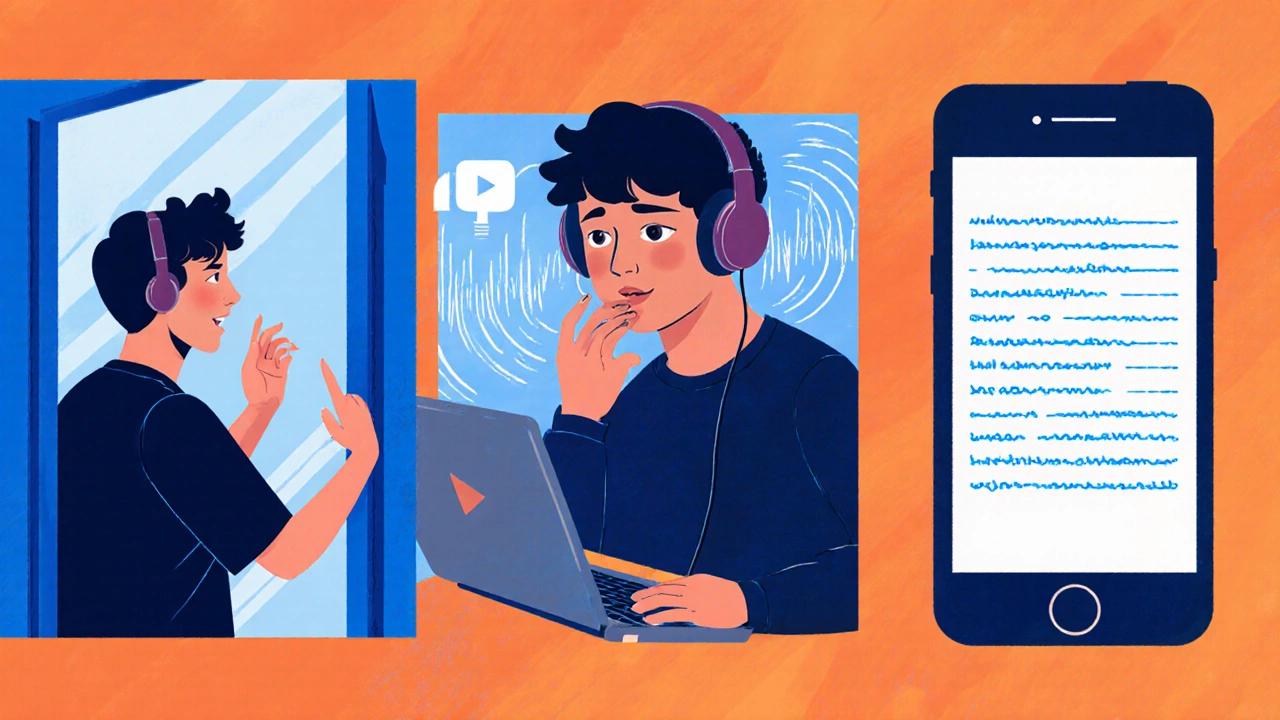Speaking Practice Tracker
Weekly Speaking Practice Tracker
Track your speaking practice and adjust your plan every two weeks
Daily Practice Log
Progress Dashboard
Goal: 30 minutes daily speaking practice
Mistakes to Focus On
No mistakes logged yet
Adjustment Suggestions
Tip: You've been practicing shadowing 3x weekly. Try adding 15 minutes of language exchange to your routine for more real-time feedback.
Tip: Your self-rating averages 3.5. Increase daily practice time to 40 minutes by incorporating morning self-talk.
Weekly Practice Summary
| Date | Activity | Minutes | Rating | Mistakes |
|---|---|---|---|---|
| Mon, Mar 18 | Shadowing | 25 | 4 | None |
| Tue, Mar 19 | Self-talk | 30 | 4 | "I go" instead of "I went" |
| Wed, Mar 20 | Exchange | 20 | 3.5 | Article usage |
self‑study English can feel overwhelming, but with the right plan you’ll be chatting confidently in months, not years.
- Set clear, measurable speaking goals.
- Build a solid vocabulary foundation before you start talking.
- Practice aloud daily using low‑stakes methods.
- Leverage free online tools and language‑exchange partners.
- Track progress and adjust your routine every two weeks.
What “English speaking” Really Means
English speaking is the ability to express thoughts, feelings, and information in spoken English with enough accuracy and fluency to be understood by native listeners. It involves three core skills: pronunciation, lexical choice, and real‑time thinking.
Lay the Groundwork: Vocabulary and Grammar Basics
Vocabulary is the toolbox you pull from when you speak. Start with the 2,000 most common words-studies show they cover roughly 80% of everyday conversation. Flashcard apps, spaced‑repetition (SRS) systems, and simple sentence‑building exercises keep these words fresh.
Grammar gives structure to that toolbox. Focus on the present simple, present continuous, and basic question forms. You don’t need to master every rule before you talk; just enough to keep sentences understandable.
Pronunciation and Accent: Small Tweaks, Big Impact
Pronunciation is often the stumbling block for self‑learners. Record yourself reading a short paragraph, then compare it to a native speaker’s version on YouTube or a pronunciation app. Pay attention to vowel length, consonant clusters, and sentence stress.
Don’t aim for a perfect native accent-clarity matters more. A simple rule: mimic the rhythm of native speech rather than individual sounds. This approach improves intelligibility quickly.

Speaking Practice Techniques You Can Start Today
Self‑study isn’t just reading textbooks; it’s about creating speaking opportunities. Here are five low‑cost tactics:
- Talk to yourself in the mirror for 2‑3 minutes each morning. Describe your plans, what you see, or rehearse a short story.
- Shadow native speakers: play a short video and repeat each sentence immediately after hearing it.
- Use a voice‑to‑text app and check whether the transcription matches what you intended to say.
- Join a free language exchange community like Tandem or HelloTalk. Schedule 15‑minute video chats.
- Record a weekly vlog on a topic you enjoy; watch it later to spot recurring errors.
Online Resources and Technology
Online resources have exploded in the last decade. Pick tools that force you to produce speech, not just consume it:
| Tool | Primary Feature | Free Tier? | Best For |
|---|---|---|---|
| Duolingo Stories | Interactive audio clips with instant playback | Yes | Beginners needing short daily drills |
| italki (Community) | d>One‑on‑one conversation with native speakersYes (pay‑per‑minute) | Learners who want real‑time feedback | |
| Elsa Speak | AI‑driven pronunciation scoring | Limited | Those focused on accent reduction |
| Speechling | Daily coached recordings reviewed by teachers | No (30‑day trial) | Intermediate learners seeking structured feedback |
Immersion Without Leaving Home
Immersion isn’t limited to traveling abroad. You can simulate an English‑only environment by:
- Changing device languages to English.
- Watching favorite shows with English subtitles, then re‑watching without them.
- Reading news aloud from BBC or The Guardian.
- Participating in Reddit voice chat rooms on topics you love.
Building Confidence and Reducing Anxiety
Fear of making mistakes stalls progress. Reframe errors as data points. Every slip tells you exactly what to improve. Set a “mistake‑log” where you note the phrase, the correction, and a practice sentence.
Celebrating tiny wins-like ordering coffee in English or completing a 5‑minute monologue-boosts motivation. Pair these celebrations with a habit tracker to visualize streaks.
Track Progress, Adjust Your Plan
Use a simple spreadsheet or habit‑tracking app with three columns: Activity, Minutes Spent, Self‑Rating (1‑5). Review it every two weeks:
- If your rating stays below 3, try a different method (e.g., switch from shadowing to language exchange).
- Increase time on high‑impact activities, such as live conversation, by 10%.
Regular self‑assessment keeps you from plateauing.
Common Pitfalls and Pro Tips
Below are mistakes many self‑learners make and how to avoid them:
| Pitfall | Why It Happens | Pro Tip |
|---|---|---|
| Focusing only on grammar drills | Feels safe and measurable | Allocate at least 60% of study time to speaking‑only activities. |
| Waiting for “perfect” pronunciation | Fear of sounding foreign | Adopt the “good‑enough” rule: clarity > perfection. |
| Learning in isolation | Comfort of solo study | Schedule weekly live interactions; accountability matters. |
| Neglecting listening | Assuming speaking can be practiced alone | Pair each speaking session with a matching listening clip. |
Next Steps for Different Learners
Complete beginners should start with a 30‑day pronunciation challenge and a daily 5‑minute self‑talk.
Intermediate speakers can add weekly 30‑minute language‑exchange calls and start recording weekly vlog episodes.
Advanced learners aiming for fluency should enroll in a paid online speaking course for targeted feedback and push for a full‑day English immersion weekend.
Frequently Asked Questions
How long does it take to become conversational?
Most learners reach basic conversational level after 3‑4 months of consistent 30‑minute daily practice, provided they focus on speaking from day one.
Do I need a teacher to improve my accent?
A teacher helps fine‑tune subtle sounds, but many learners achieve clear speech using AI pronunciation apps combined with regular shadowing.
What free resources are best for speaking practice?
Duolingo Stories, the ConversationExchange website, YouTube “listen and repeat” channels, and the free community tier of italki are all solid choices.
How can I stay motivated when I feel stuck?
Set micro‑goals (e.g., describe your day in 60 seconds), reward yourself for each streak, and join a study buddy group to share progress.
Is it worth buying a premium app?
If you’re serious about rapid improvement, a premium app that offers personalized coach feedback (like Speechling) can shave weeks off your timeline, but the free alternatives are sufficient for most learners.
